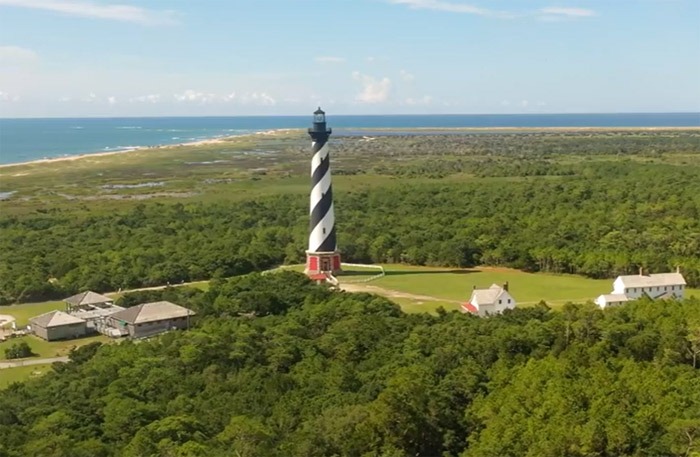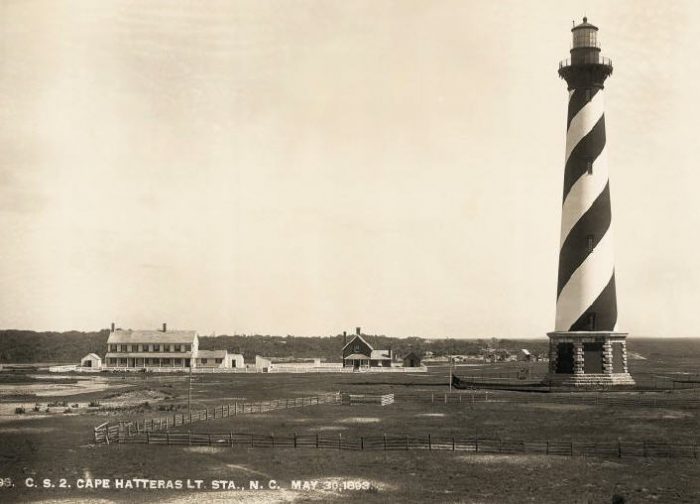
Future possibilities for restoring and rehabilitating the Cape Hatteras Lighthouse were outlined at a lightly attended public meeting on Tuesday evening, September 28, in Buxton.

Led by David Hallac, National Parks of Eastern North Carolina Superintendent, the meeting was an opportunity for the National Park Service (NPS) to present the three primary options to enhance the lighthouse and the surrounding grounds. These options include several big potential improvements, such as the replacement of the lighthouse beacon, extensive landscaping projects, and adding historical elements to bring the iconic structure back to its original 1870 glory.
The lighthouse project has been in the works for years, and the NPS has already received funding for the upcoming repairs and enhancements. The items that need to be addressed originally stemmed from the results of a 2014 Comprehensive Condition Assessment Report, and a later 2016 Historic Structure Report.
Earlier in 2021, a team of historical architects, engineers, specialist contractors, and personnel from the State Historic Preservation Office and the Cape Hatteras National Seashore got the ball rolling by removing the interior paint throughout the lighthouse – stripping the structure to its bare-bones brick interior – and identifying several surprising issues along the way.
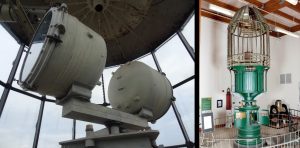
Now, the stage is set for the big next steps to be taken, which includes an overhaul of the ragged terrain bordering the lighthouse, extensive repairs to the metalwork and other inherent features, and the replacement of the famous beacon with either the original 1854 Fresnel lens, (which is currently housed at the Graveyard of the Atlantic Museum in Hatteras village), or an identical-looking replica.
Hallac outlined some of the damage that was uncovered during the paint removal process, such as deep cracks or patches of stucco-like material that had apparently been used at some point in the past 150 years to repair some sort of unknown issues. “Our historic architects are starting to both literally and figuratively dig into these problems, and help us understand what should we do next,” said Hallac.
But on a grander scale, Hallac also noted that in addition to repairs, a good chunk of the upcoming work will likely focus on replacing many of the lighthouse’s modern additions with more authentic elements.
“Part of this project’s goal is to have as much of the original lighthouse restored as possible,” he said. “We’re seeking to fix all these issues, but also put these character-defining elements [from 1870] back into the lighthouse.” A prime example is the future replacement of the current light at the top, which is currently a modern beacon from around the 1950s.
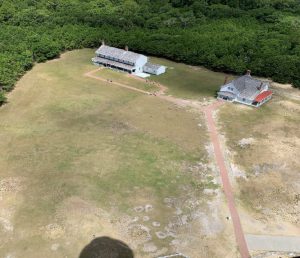
“The landscape is also in disrepair,” he added later in the presentation, showing photos of the worn paths and patches of sparse grass that indicated years of heavy foot traffic. “So we are looking at ways to improve visitor circulation around the landscape, and restore the landscape… Additionally, we will be adding a replica fence around the keepers’ quarters, and will be enhancing the interpretive [displays] so visitors can have a much more immersive experience, and learn more about what they’re seeing.”
Though the overall lighthouse restoration project has been steadily progressing over the past several years, the current step in the process is in the public review phase, and at Tuesday’s meeting, Hallac presented the three main options available:
Alternative One: No action at all. Hallac stated that due to the extensive repair work needed, and the funds already available, the “No Action” option was highly unlikely. Regardless, this option includes the following:
- No repairs.
- No changes to landscape or circulation.
- The existing light beacon remains, (or is replaced with another modern beacon.)
Alternative Two: Improvements to Landscape and Lens. Alternative Two is the more modest of the two “action” options when it comes to the landscape, and includes the following:
- New pedestrian paths.
- Plantings and landscape improvements. (See image below.)
- Reproduction of the original Fresnel lens and replacing the existing modern beacon. (The Fresnel lens is on loan from the NPS at the Graveyard of the Atlantic Museum in Hatteras, and will likely remain where it is.)
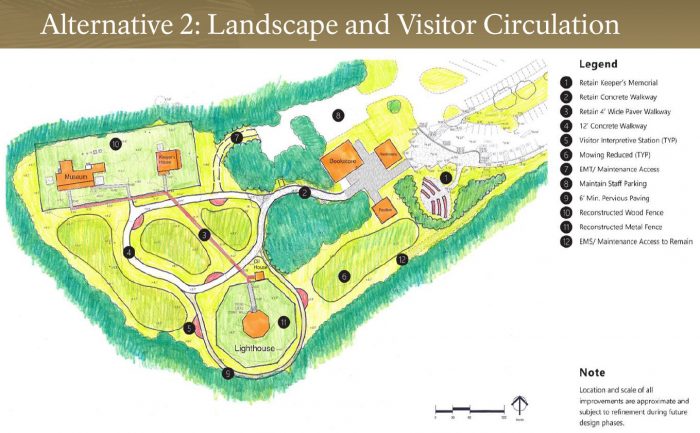
Alternative Three: Comprehensive Improvements. This option has several distinctive differences from Alternative Two, such as more elaborate landscape alterations, and returning the original Fresnel lens to the lighthouse, as opposed to creating a replica. Alternative Three includes the following:
- Multiple new pedestrian paths and the addition of a shade pavilion. (See image below.)
- Sculpting gently raised berms to restore the natural landscape.
- Partially or completely restoring the original Fresnel lens, and reinstalling it at the Cape Hatteras Lighthouse with a new modern light source.
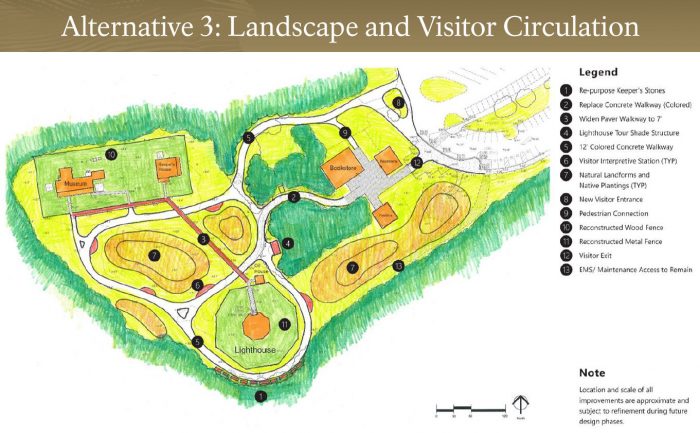
Both Alternatives B and C will also include the following:
-

The oil house at the base of the lighthouse will have its “modern” features, (namely the door and canopy), replaced with historic elements. Restoring and rehabilitating the lighthouse and oil house to remove non-historic features and replace historic elements.
- Adding replica stockade fencing around the keepers’ quarters.
- Adding interpretive elements, such as educational displays around the landscape.
- Other proposed actions include:
- Masonry repair
- Painting
- Marble floor tile
- Restore missing doors and window pediments
- Oil House restoration
Hallac stated that the exact timeframe for either of the two action options is somewhat unknown, but he expected the upcoming repairs and renovations to take a minimum of 24 months. “When we’re looking at scheduling, we’ll try to do it as quickly as possible, but we also don’t want to rush it,” he said. “It’s going to take some time, and we will also probably see a few ‘surprises’ that will [need to be repaired as well], just as we did when taking the paint off.”
The public comment period is a total of 30 days, from September 17 to October 17.
After assessing the public’s feedback on the proposed alternatives, an environmental assessment will be performed, and hopefully released by the end of the year. Then, there will be another 30-day public review period before a final decision is made on the preferred alternative in the spring of 2022, followed by contractor bidding. “We hope to have the project underway around this time in 2022,” said Hallac.
Comments can be submitted electronically at https://parkplanning.nps.gov/caha_lighthouse, or can be mailed to Cape Hatteras National Seashore, ATTN: Superintendent, 1401 National Park Dr., Manteo, N.C. 27954. The deadline to submit comments is Oct. 17, 2021.
For more information on the ongoing Cape Hatteras Lighthouse restoration, including current projects and timelines, visit https://www.nps.gov/caha/learn/news/cape-hatteras-lighthouse-restoration-project.htm.


